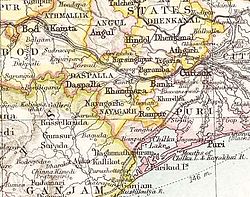Banki State
| Banki State | |||||||
|---|---|---|---|---|---|---|---|
| Princely State of British India | |||||||
| 1807–1840 | |||||||
 Banki in the Imperial Gazetteer of India | |||||||
| Area | |||||||
• 1881 | 300 km2 (120 sq mi) | ||||||
| Population | |||||||
• 1881 | 56900 | ||||||
| History | |||||||
| History | |||||||
• Established as a British protectorate | 1807 | ||||||
• Annexed by the British Raj | 1840 | ||||||
| |||||||
| Today part of | Odisha, India | ||||||
Banki or Bānki State was a princely state in Odisha during the British Raj. Its capital was Banki, in the western part of present day Cuttack district.[1]
The last Raja was arrested for murder and Banki State was subsequently annexed by the British Raj. Until 1840, it paid an annual tribute of £443.
History[edit | edit source]
Banki was a zamindari state of Orissa located in the hilly area to the west of Cuttack district. The predecessor state had been ruled by a powerful Raja who in the 17th century had established the zamindari of Dompada as a gift to his second son.[2]
The river Mahanadi flowed to the north of the state, separating it from Baramba and Tigiria. It was bound in the south by Puri district and in the west by Khandpara State; a little part of the state was located north of the Mahanadi. The state included 177 villages, the most important of which were Charchika, Baideswar, Kalapathar and Subarnapur.
Banki became a British protectorate in 1807 following the defeat of the Maratha Empire in the area. In 1821 it was made part of the Feudatory States of Orissa.[3] The population grew from 49,426 inhabitants in 1872 to 56,900 in 1881, with a density of 377 per square mile in 1901.[4] 99.5% of the population were Hindu and the main ethnic group in the hills were the Juang people.[5]
Rulers[edit | edit source]
The rulers of Banki State bore the title 'Raja'. In 1840 the last Raja was deposed and the state was confiscated after he was condemned by a British tribunal to life in prison for murder. After annexation Banki was put under direct control of the Bengal Presidency, being administered by the Cuttack Commissioner.
Rani Sukadei[edit | edit source]
Rani Sukadei (1686 A.D. - 1726 A.D.) was an Indian queen of the princely state of Banki, Odisha. She is known for her display of courage and bravery in the battles against Gajapati of Khurda. She is regarded as the only undefeated warrior queen in Indian history.
Rajkumari Sukadei of Badamba married the King of Banki, Maharaja Dhanajay Trilokyanath Harichandan Deb. Their union strengthened the ties between the two princely states, Banki and Badamba. As the queen of Banki, the Rani took keen interest in the welfare of her subjects. The King and Queen visited the Jagannath temple at Puri and on their way back to Banki, they were invited by the King of Khurda, Gajapati Gopinath Deva at his court. It is said that when the Raja and Rani paid a visit to Gajapati. Gajapati at Sukadei's first sight got attracted to her so much so that he planned an attack on Banki in order to woo her as soon as the King and Queen departed for Banki from Khurda.
Raja Dhanajay refused to accede his kingdom to Khurda on Gajapati's demand, thus decided to fight a war with the Gajapati. In the battle of Ragadigrama, the combined armies of Badamba and Banki fought with the army of Khurda. The Gajapati's army still outnumbered the combined armies of the defendants. Raja Dhanajay suffered huge loses at the hands of Gajapati. He was ultimately killed in the battle.
When this news reached Sukadei it devastated her but then she got determined to protect her husband's kingdom. Only when the commanders of Banki had accepted defeat. Sukadei emerged and motivated the soldiers and commanders not to lose hope. She declared that the war is not over and she shall herself lead the army to the battle ground. In the afternoon Sukadei marched with a troop of 700 soldiers towards the Gajapati's camp. Both the armies again met at Ragadigrama. Sukadei single handedly killed several soldiers of the Gajapati's army. She challenged the Gajapati for a fight. Gajapati, undermining her abilities, stepped down from his horse to fight with her accepting her challenge. The valiant queen defeated the Gajapati and captured her, thus ending the war.[citation needed]
See also[edit | edit source]
References[edit | edit source]
- ↑ Banki, India Page
- ↑ "Dompada (Zamindari)". Archived from the original on 24 January 2019. Retrieved 14 January 2016.
- ↑ L. E. B. Cobden-Ramsay, Feudatory States of Orissa: Bengal District Gazetteers, Logos Press, 2011
- ↑ Imperial Gazetteer of India, v. 11, p. 89.
- ↑ Great Britain India Office. The Imperial Gazetteer of India. Trübner & co. London, 1885.